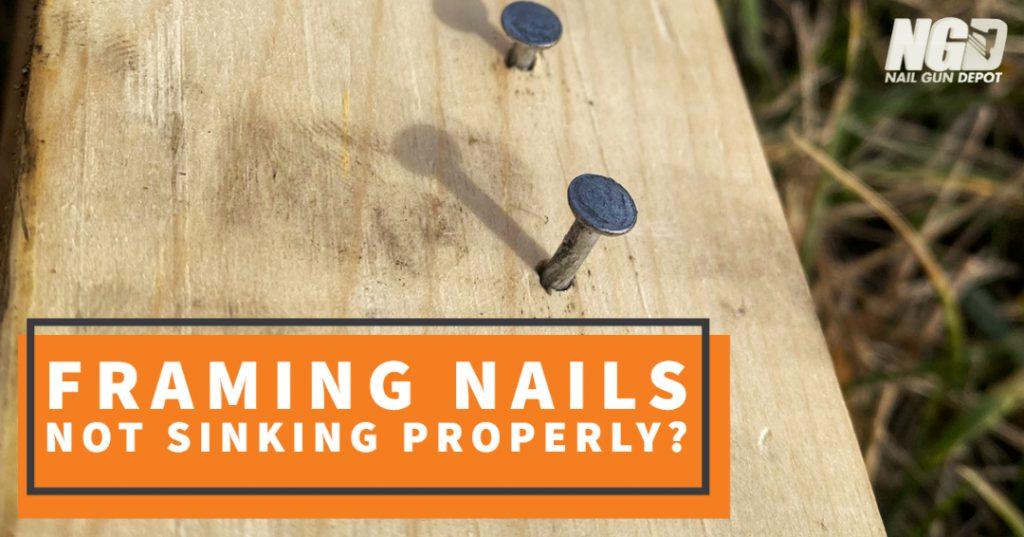Why Is My Framing Nail Not Sinking Properly?

Framing nailers are traditionally used for securing wood-to-wood framing. Pneumatic or cordless, framing nailers will save you time and money when used properly, but sometimes require maintenance to operate to their fullest potential. One common question we hear, users experience the inability to sink nails properly when using their nailers.
Also known as sitting proud, a nail not properly sunk can lead to weak framing that does not meet building code - not to mention the frustration of needing a framing hammer to finish the job. Let’s explore several common causes for a framing nailer to not sink nails properly.

Cause 1: Incorrect depth settings
One of the most common causes for a framing nailer not sinking nails properly is incorrect depth settings. Make sure to check the depth-of-drive settings on the framing gun in question; then run the nailer at max pressure (120 PSI) to see if the issue has resolved itself.
Cause 2: Incorrect Nail Size
Number two on our list, the use of incorrect nail size. Every framing nailer has different specifications for the size of nail they can drive. Using nails that are not the recommended diameter or length can cause the tool to malfunction. It is important to check the owner's manual for your specific framing nailer to see what gauge and length of nail it requires.
The length of the nail from top to bottom and the diameter of its shank can vary by the type of framing nail gun and manufacturer. Using the wrong diameter or length fastener can lead to nails not being fully driven, or not being driven period - as the nailer is likely to jam.
Cause 3: Low Air Pressure
Another common cause for a framing nailer not sinking nails properly is low air pressure. Pneumatic framing nailers rely on compressed air to drive the nails, and if the air pressure is too low, the nails won't sink properly. Make sure to check the air pressure gauge on your compressor to ensure it's at the correct level.
Cause 4: Hard Material
Framing nailers are designed to work with certain types of wood, and if the material being used is too hard or dense, it can cause the nails to not sink properly - or at all. Some hard materials such as exotic hardwoods, engineered lumber, or laminated veneer lumber (LVL) can be challenging for the framing nailer to drive with enough force to leave the nail head flush with the surface.
It's important to be aware of the material being used, making adjustments accordingly to ensure the framing nailer performs to its fullest potential.. Not all nailers have a driver that is powerful enough to sink properly in LVL.
Senco’s new Fusion framing nailer addresses this with their onboard air booster, which employs a standard tire chuck, allowing you to “charge” the otherwise cordless (battery-powered) nailer with an additional reserve of compressed air. This allows the gun to drive framing nails into denser substrates, as can be seen here on the Senco F35 Fusion. Watch more about the Fusion line on our YouTube.
Cause 5: Grease and Cleaning
Less common, but still relevant, you may find the presence of built-up grease inside the tool. Several new guns come packed with grease, so it's important to take the nailer apart and clean it properly before use. Once cleaned, add pneumatic tool oil and try again.
Cause 6: Worn-Out O-Rings
Worn-out O-rings can also cause a framing nailer not to sink nails properly. O-rings are responsible for sealing the tool and keeping the compressed air inside, and if they become worn or damaged, the tool can lose pressure and malfunction. Make sure to check the O-rings on your framing nailer regularly and replace them as needed.
Cause 7: Broken Drive Pin
Another issue that framers face is a broken or chipped drive pin, which can cause the nails to be driven at the wrong angle or left sitting proud. To check if this is the case, pull the nose off the gun so you can see the end of the pin.
This can happen due to wear and tear of the tool, or due to improper usage of nails. If the nails are too long or too short, it can cause the drive pin to break or chip. If you notice the drive pin is flawed, it is important to replace it as soon as possible to prevent any further damage to the framing nailer.
Cause 8: Dirty or Blocked Air Filter
The air filter is responsible for keeping debris and dust out of the tool. If it becomes clogged, it can restrict the flow of air, causing the framing nailer to malfunction. Make sure to check and clean the air filter regularly to ensure proper performance.
NOTE: This mainly applies to cordless nailers engineered with an air-drive system.
Conclusion
A framing nailer not sinking nails properly, or failing to perform as expected, can be a frustrating issue; but with a little knowledge and some basic troubleshooting, it doesn’t have to halt progress while on the job. By checking the nail size, air pressure, air filter, O-rings, depth settings, cleaning the gun, and checking the drive pin, you can identify and solve the problem quickly 99.9% of the time. Regular maintenance and attention to detail will ensure that your framing nailer continues to perform at its best.
Remember, always refer to the owner's manual for your specific nailer, to ensure you are using the proper nails and following the recommended maintenance schedule. With the right knowledge and care, your framing nailer can continue to perform its job efficiently and effectively, making your work more productive and profitable.


